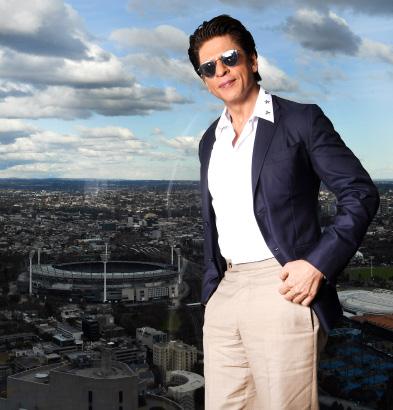
AUGUST (2) 2019 1 NATIONAL EDITION SYDNEY FREE FORTNIGHTLY Vol. 26 No. 11 (2) AUGUST (2) 2019 indianlink.com.au LINKING INDIA WITH AUSTRALIA SYDNEY • MELBOURNE • ADELAIDE • BRISBANE • PERTH Level 24/44 Market St, Sydney 2000 • GPO Box 108, Sydney 2001 • Ph: 18000 15 8 47 WINNER OF 22 MULTICULTURAL MEDIA AWARDS SRK seduction





2 AUGUST (2) 2019 www.indianlink.com.au







AUGUST (2) 2019 3 NATIONAL EDITION






PUBLISHER
Pawan Luthra
EDITOR
Rajni Anand Luthra
DEPUTY EDITOR
Sneha Khale
SOCIAL MEDIA
Suruchi Sehgal
MELBOURNE COORDINATOR
Preeti Jabbal
CONTRIBUTORS
Gurmeet
ADVERTISING MANAGER
Shriti Sinha 0410 578 146
ADVERTISING ASSISTANT
Charuta Joshi 02 9279 2004
Indian Link is a fortnightly newspaper published in English. No material, including advertisements designed by Indian Link, may be reproduced in part or in whole without the written consent of the editor. Opinions carried in Indian Link are those of the writers and not necessarily endorsed by Indian Link. All correspondence should be addressed to:
INDIAN LINK MEDIA GROUP
Level 24/44 Market St, Sydney 2000
GPO Box 108, Sydney 2001
Ph: 02 9279-2004
Fax: 02 9279-2005
Email: info@indianlink.com.au
Diaspora and dissent
BY PAWAN LUTHRA
As Hong Kong becomes a city fighting for its rights from China, the squabble has spilled on to the streets and universities around Australia. In recent days, pro-Hong Kong protesters were taunted with expletive-laden chants from proChina activists before scuffles broke out in Melbourne and Adelaide. Violence has erupted at some of these rallies, with videos emerging of the two groups clashing with each other and punches thrown. While there are allegations that the proChina students are being directed by Chinese authorities, there are also comments that the mainland students are being ‘spontaneously patriotic’.
So, when does dissent against opposition to your country of origin become acceptable? What about the Indian diaspora in Australia: at what stage does one fight back against what one feels might not be in the best interests of India?
In today’s world of fast flowing information and globalisation, news from ‘back home’ is received as soon as it breaks. Thirty years ago, when handwritten mail and landline phones ruled, there was a high level of disconnect with the politics in the mother country. Nationalism was always there, but it was patriotism delayed. Not so anymore. The daily news diet of most Indian Australians is made up just as much of what is happening in India as it is of local issues, if not more so. Whether this is good or bad, is a discussion for another time.
With this increased flow of information, the unconditional love for India is in inverse proportion to the amount of time one has lived here. And as the Indian diaspora is composed largely of new migrants, chances are that they will be ‘spontaneously patriotic’ in their actions.
This was clearly demonstrated by the very public rally in the streets of Sydney’s CBD against Pakistan when the Pulwama attacks took place. The rallies were loud and clear and brought sub-continental politics to our shores.
Perhaps there is another way to
show unconditional love for country of origin. A page can be taken from the book of the Jewish diaspora who seldom, if ever, take to the streets for their cause, rather are able to convey their terms to the powers that be, in a manner which cannot be ignored.
Time for the Indian-Australian community to win their debate through their intellect rather than with their brawn. To go about this, acquaint the local media with your views. Be strategic about your arguments rather than plain emotional. Present the facts and the background in a clear and concise manner. The local community is well regarded for its education:bring this to the fore when arguing for your side of the story.
Neither at the State or Federal levels is there an active group to lobby for all things Indian in Australia. It is time for the formation of ‘Friends of India’ political forums at both State and Federal levels so that, well, wellplaced Friends can be made who can understand the Indian perspective on various issues.
The diaspora can be ‘spontaneously patriotic’ in a more effective way than at street marches or clashes at rallies.

AUGUST (2) 2019 5 NATIONAL EDITION
Kalsi, Nanditha Suresh, Smriti Sekhar, Chitra Sudarshan, Petra O’Neill, Auntyji
EDITORIAL




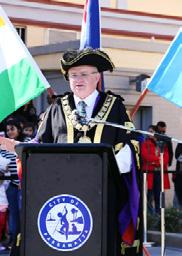
6 AUGUST (2) 2019 www.indianlink.com.au Highlights from the Indian Film Festival of Melbourne 2019 10 23 COVER STORY 31 16 SPECIAL FEATURES 16 SPECIAL FEATURE Independence Day celebrations 23 ENTREPRENEUR Baker Mum Melissa Domingo Rawat 26 BOOKS David Shulman’s Tamil:ABiography 31 CULTURE DIARIES What we’re loving right now at Indian Link 34 TRAVEL Cruising the South Pacific CONTENTS 34











AUGUST (2) 2019 7 NATIONAL EDITION
YOUR SAY
AAJA NACH LE!
RAJNI ANAND LUTHRA reviewed the inaugural Nach Le Sydney Bollywoodstyle dance competition.

Bollywood Dimensions wrote: Congratulations to all the winners of the Nach Le Sydney competition! Our instructors had an amazing time competing and can't wait to bring some fire again next year. Thank you to @indian link @indianlinkradio for providing us with this great opportunity.
Bolly Boom Dance wrote: So proud for the Pink Bride Tribe! Our first dance competition and we all had fun, including the audiences. Thank you #nachlesydney for organising this event.
Juhi Bhavsar of Nrityam Performing Arts wrote: Great thank you for having voted for us, audience, Janta Janardhan! You are always supportive and give us more confidence to bring something new with our Bedas every year. Love you all.
Sanjana Chandawarker wrote: One impromptu decision to compete, a couple of days putting together a routine and less than a week to drill, earned me one beautiful partner in crime, rehearsal memories that I will cherish and of course a first place at #nachlesydney! Thank you @indianlink for reaching out, organising this initiative, and giving me more things to be grateful for.
spritzersmritz7 wrote: @indianlink team are incredible! Congratulations on an amazing performance Sanjana.
WHEN SHAH RUKH KHAN MET THE STUDENTS AT LATROBE

On our video post of Shah Rukh Khan mingling with and performing for the students after the formal convocation ceremony.
Fleur East wrote: Special memories! It was so exciting to see him dance and do lines from his films just a few feet away!! And when he came down to meet his fans... I found myself with my hand on his shoulder! Total fan!!
Dolly Seepersaud wrote: Awesome.
Jodie Sly wrote: So accommodating.
Betty Jager wrote: King of Bollywood.
Sue Kennedy wrote: He was such a honey, and so sweet.
Neelu Upadhyaya Poudyeal wrote: I wish I was there.
Meeramar wrote: SRK love!
Farhat Hamid wrote: UNSW is not far from La Trobe, just saying.
Talha Manzoor wrote: Check out the size of the gathering…

Kulbir Minhas wrote: He should go down to meet the audience.

Ravinder Bansal wrote: Love you Shah Rukh Khan!! Will wait for you to come back again!!
Con Junz Ian wrote: This was an awesome day.
Karisma Takah wrote: Should have tried to check it out after all.
Ravinder Bansal wrote: Missed it big time
Gurinder Kaur wrote: Spotted you, Gurneet Kaur!
Puneet Kaur wrote: Missed him!
Jacy Khan wrote: Thank you for the beautiful pictures, was waiting for them. Priceless moments, beautifully captured.
Sonya Meena Odhavji wrote: Beautiful shots.
Anju Handa wrote: Such a graceful personality, God bless you Shah Rukh.
Hardeep Madan wrote: He’s a jolly good fellow, and so say all of us.
MELBOURNE’S PERFECT DAUGHTER-IN-LAW
PREETI JABBAL reviewed the new Indian restaurant Daughter-in-Law on Little Bourke St, Melbourne.

Harpal Singh Batra wrote: Thanks Preeti Jabbal. I knew you would fall in love with the place.
Amardeep S Batra wrote: Been there and second your opinion.
Harvinder Rosy Bhagat wrote: Interesting name! Will have to check out, I suppose!
Sonia Batra wrote: Superb!
Ranjana Sharda Dutt wrote: Added on the wish list.
SAY IT AGAIN
WHERE IN INDIA
We asked you to name this village of twins. The unusual twin population is not only limited to humans but animals too.
A tough one, we admit. The correct answer is Mohammadpur Umri, a small village located near Allahabad.
2019 Bedtime for kids: put down your smartphone, read a book with them
2039: Take off your VR headset, read a tablet 2059: Deactivate your neural interface system, put on your VR glasses
2079: Emerge briefly from the singularity, spend some time in a four dimensional universe. Ketan Joshi, Climate, clean tech and science communicator
Today we are proud to launch our five-year India strategy, ‘Engaging with India 20202024’, highlighting cooperation in health, water, law, cultural arts and postgraduate teaching and learning.
University of Melbourne
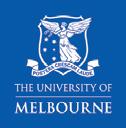
8 AUGUST (2) 2019 www.indianlink.com.au
Photo: La Trobe
A NOTE ON INDEPENDENCE DAY
PAWAN LUTHRA wrote about the freedom of citizens in independent India.

Krish Na wrote: Well written, Pawan. Freedom comes at a cost, but looks like there’s been a lot of inflation!
BN Sudarshan wrote: The editorial in the Indian Link August (1) issue sends a good message. You noted: "In the recent past, the ability to engage in active debate on a number of subjects has become stifled." Salutes to the bold observations you continue to make.

CAPTION CONTEST
What’s the chitchat here between Alia Bhatt and Varun Dhawan?
Farzana Nisha wrote: Alia: I’m not doing another movie with you until next year… Varun: Radha on the runway, Radha likes to fly, Radha likes to argue, move that desi body.
Rachna Gupta wrote: Alia: Main khoj rahee hun ke kisko
Rishi Singh wrote: Varun to Alia: Tere ko har jagah Ranbir nahi dikhega.
Bhupinder Smyra Aggarwal and Kadambari Mishra wrote: Tera dhyan kidhar hai, yeh tera hero idhar hai, palat
Amita Gill wrote: Varun: Alia, you look elegant in your Simar Dugal outfit.

Arix Bishnoi wrote: Plane mera videshi par swag mera desi!

Bhaswati Banerjee wrote: Varun: Alia, do you like Formula 1?
Alia: No I hate maths.
Arix Bishnoi wrote: Aaja meri gaadi main baith ja!
Mamta Sharma wrote: Yeh kahan aa gaye hum, yuhi sath sath chalte
Anurag Singh wrote: Varun: Raksha bandhan pe kya kar rahi ho, didi?
INSTA-HAPPY
Send us a photo or Instagram one of Indian Link in your daily life using the hashtag #indianlink. We’ll pick one to feature in this column.
Sandeep Pandit wrote: That beautiful moment in life, when you’re the reason for the smile on Mum’s face! Thank you #indianlink and Suruchi Sehgal for giving me this moment.
WHO WORE IT BETTER?
84% Kareena Kapoor
WHERE IN OZ
We asked you to name this giant hedge maze.

Neha Rajpal and Gayathri Arulraj correctly identified it as Amaze’n Margaret River, WA
Times have changed. It used to be American parents scolding their kids like “Don’t throw away food, Billy; there are starving kids in India.” Now Indian parents are like “Don’t throw away your BMWs; there are kids in America driving Kia Sorrentos.”
Trevor Noah, host of The Daily Show

Welcome news for the #WarOnWaste. Professor Veena Sahajwalla and team awarded $3.3 million to continue transforming Australia’s waste and resource recovery industry.

UNSW Science
16% Michelle Williams

It’s such a wonderful university. Please use this opportunity, girls. Lots of luck to all of you.
Shah Rukh Khan, on La Trobe Uni’s announcement that submissions to the Shah Rukh Khan scholarship will close on 30 Aug 2019
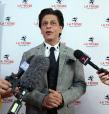
AUGUST (2) 2019 9 NATIONAL EDITION
KAREENA KAPOOR OR MICHELLE WILLIAMS IN ATELIER ZUHRA
SRK seduction
Shah Rukh mania sweeps Melbourne




10 AUGUST (2) 2019 www.indianlink.com.au COVER STORY
BY PREETI JABBAL

Why’s he wearing his sunglasses indoors, ABC TV presenter Virginia Trioli asked. Her colleague Georgie Tunny, who had just interviewed Shah Rukh Khan, replied, “Shah Rukh does what Shah Rukh wants.”
Tunny is one of many new fans Shah Rukh has won in Australia.
Described repeatedly as “India’s - the world’s - biggest movie star”, Shah Rukh Khan wowed everyone he engaged with on his brief trip down under as a guest of the Indian Film Festival of Melbourne (IFFM) - including, in all probability, the koala and the python that were brought out to welcome him at LaTrobe University.
He had impeccable manners - kissing the women, looking genuinely thrilled as he received the LaTrobe and IFFM honours, remembering lines from his movies, joining the fans to shake a leg - and left the mainstream in awe just as much with his star appeal as with his humility.
Bollywood’s undisputed king Shah Rukh Khan (SRK) enjoyed adulation from thousands of adoring fans that braved the inclement weather to catch a glimpse of their favourite star.
From his first public appearance at the Press Conference held at Collins Street to the after party at the IFFM Awards Night, SRK did what he does best – he charmed irresistibly.
The dimpled smile, witty remarks and chivalry were all out on full display at his first appearance at the media meet, as he held the chair open for fellow actor and festival guest Tabu and then cheekily blamed her for the late start. Of course the actress forgave him in a heartbeat, as did everyone else that was kept waiting at other events thanks to his chronic inability to keep time. We hope it’s because he hopped from commitment to commitment and not because he was just fashionably late. He remembered his last visit to Melbourne in 2006-2007 during the filming of Chak de India when he was a rising superstar, making many hit films and being
declared the sexiest man in Asia.
“So I come back here again, still a rising superstar, not making too many hit films… in fact, trying desperately to do so, but still irrepressibly the sexiest (even) today,” he said, tongue in cheek.
He went on to thank the Indian diaspora and the Indian Film Festival of Melbourne for their contribution in bringing Indian films to the world.
The large number of media folk at the press meet remained mainly focussed on SRK, as if he was the only person they came to meet. So he carted the microphone around for every panel member to have a say, and not feel left out. Charming as well as magnanimous, was the general consensus.
The SRK seduction continued at the Awards Night held at the Palais Theatre, where security had their work cut out keeping the screaming fans from mobbing him as he entered through the aisles. He waved, shook hands and blew kisses, and they tripped over themselves in their attempts to get closer, and to take that all important selfie.
The glamorous awards night had much to offer but the audience was clearly restless to hear from King Khan till he finally obliged. Accepting his award for Excellence in Cinema IFFM 2019, he couldn’t go past a

few lines of his written speech before the audience started yelling out his name and professing their undying love for him.
The King of Romance raced through his formal speech to return the sentiment with some popular romantic dialogues from his films addressed to the women in the audience. Selfies temporarily forgotten, they all but swooned.
Acquiring some new fans SRK voluntarily joined Emotion21Inc, a group of dancers with Down syndrome and proved yet again how well he connects with and touches people, a craft that amplifies his personal brand.
As yesteryears actress Simi Garewal claimed, the star is richer than Tom Cruise (who, you ask) with a networth of over $600 million, he owns land on the moon, has a perfume to his name and the Paris museum once released a limited edition coin with his image that is worth a fortune today.
Dishing out wisecracks at every opportunity, SRK’s humour was lapped up by an appreciative crowd, the piece de resistance of the gala being his impromptu signature moves on the hit song Chaiya Chaiya that worked like a charm.
Enjoying a brief encounter with Australian native animals at Melbourne’s
LaTrobe University, he confessed that it was his first encounter with a snake and that he was ‘touched’ by the python that was put around his neck in welcome.
After instructing the gathered media in his signature open-armed pose, he joined a formal and impressive academic ceremony to accept an honorary degree. The Doctor Of Letters honour was awarded to SRK in recognition of his outstanding achievements within the entertainment industry, for his ongoing championship of human rights and his advocacy for social justice.

Felicitating him, University Chancellor John Brumby recognised his wide-ranging humanitarian work, including establishing the Meer Foundation to support and empower women who have survived acid attacks in India.
During his occasional address SRK briefly explained the inspiration and purpose behind establishing Meer Foundation and said, “This is not an award for anything that the Meer Foundation might have achieved. It is for the courage of every woman who faces the brutality of injustice, inequality and inhumanity.”
La Trobe University also announced the Shah Rukh Khan La Trobe University PhD Scholarship, providing an opportunity for an aspiring female researcher from India to complete her general Scholarship in LA Trobe University. The four-year full fee research scholarship is valued in excess of $200,000.
Shah Rukh remarked that university is a place where youngsters have opportunities not just for academics and extra curriculars, but also for a better life, and to offer that opportunity to a girl from India is a wonderful gesture by La Trobe.
Later that evening SRK officially opened the Indian Film Festival of Melbourne 2019 as their chief guest and major drawcard. The Festival opened with the screening of Bulbul Can Sing, an acclaimed film by director Rima Das.
Conferred with many titles ranging from Doctor, Knight, King Khan to Badshah of Bollywood, it was clear that Shah Rukh inspires devotion like no other. In his few days here, the charismatic star provided plenty of fodder to the media, local and mainstream and his appeal has since only quadrupled…
More power to brand SRK.
AUGUST (2) 2019 11 NATIONAL EDITION
Photos: Ravinder Jabbal
Top Ten at IFFM
1. IT’S A BRAVE WORLD OUT THERE

The Festival’s theme of Courage was explored through films curated well as the Short Film Competition. Submissions were accepted from filmmakers from India and Australia in the form of a narrative or documentary.
Ali Mousawi took the coveted prize for his movie My Name Is Mohammad and Raghad, We Don’t Exist Here Anymore, based on a true refugee story. Genevieve Clay received accolades for her film Be My Brother based on a differently abled person.

The two winning entries were played to a packed audience at the IFFM Awards Night held at the Palais Theatre. Director, screenwriter and lyricist Vijay Krishna Acahrya had the unenviable job of shortlisting the entries, choosing from some incredibly talented filmmakers with
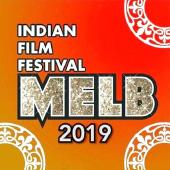
arresting vision. Admittedly, he presented a rather long section for the Short Film competition on the night, the declared winners receiving a trip to India and a camera from Black magic Design.
2. IN PERFECT SYMPHONY
In a true meeting of East and West the renowned Melbourne Symphony Orchestra tailored their repertoire to play a musical tribute to the cinematic legacy of Indian actor Shah Rukh Khan.



They played a medley of his songs including soundtracks from Kuch Kuch hota Hai, Dilwale Dulhania Le Jayenge, Kal Ho Na Ho and other SRK classics. Their outstanding musicianship was on brilliant display as they accompanied playback singer Amaal Malik for his short appearance on stage. With music well suited to the young singer’s personal style of mixing various genres such as jazz,

electronic, Indian classical and pop, the mood turned decidedly serenade with Amaal’s rendition of Mein rahoon ya na rahoon. The best of Indian cinema collaborated with the best in orchestral music and the result was no less than magical.
3. SASS AND SPARKLE
IFFM’s annual Awards Night recognised some outstanding performances and contributions to Indian cinema. Many glammed up despite freezing temperatures and braved the winds to rub shoulders with some big names in the Indian film industry and celebrate their achievements.
Among the ecstatic recipients on the night were Tabu who took the Best Actress award for Andhadhun, and Sriram Raghavan who won the Best Director for the same film. South Indian actor Vijay Sethupathi collected the Best Actor award
for his challenging transsexual role in the LGBTQ genre dark thriller Super Deluxe.
Best Indie Film went to Bulbul Can Sing, Best Film Gully Boy, Diversity Award to Onir, Equality in Cinema award to Chuskit and Super Deluxe. Excellence in Cinema was awarded to Shah Rukh Khan and Simmba snapped up the Telstra People’s Choice award.
In a combination of escapism and social relevance, education and entertainment, the winning films explored a landscape of feelings and emotions that were deeply human and touched at various levels.
The awards recognised standout artistic and story elements, voted by Golden Globe winner Fred Schepisi, film editor Jill Bilcock, film critic and columnist Rajeev Masand, actress, writer, producer Victoria Hill and Australian film, theatre, TV artist Vince Colosino.
12 AUGUST (2) 2019 www.indianlink.com.au
Countless moments make up an event as major as the tenth edition of IFFM, one of the most eagerly awaited events on the Australian Indian community’s annual social calendar. Here are some that stood out to us - moments when the forces came together to make the magic happen and take us to a place of heightened emotions.
COVER STORY
4. PATRIOTIC KJO
Patriotic sentiments were high at the Flag
Hoisting event held at iconic Federation Square prior to India’s Independence Day on 15 August. Film producer and talk show host Karan Johar was given the honour of hoisting this year.

Coinciding with Prime Minister Modi’s highly controversial abrogation of Article 370 from Jammu and Kashmir, the ceremony in Melbourne was preceded by protests and demonstration from the two opposing factions affected by the move. Entry was free but weather was fierce so it was not as crowded as previous years. However a sizeable number of people from the community did turn up.
Karan Johar said, “This has been an emotional and proud moment for me and hoisting the flag and singing the national anthem with all of you has made my heart feel all the love we have for our great country, India.”
India is not just a country but an emotion, he noted, and he should know, given he has milked the emotion that is India in his hugely successful films.
To sum up he quoted some beautiful words penned by the legendary Gulzar in last year’s hit film Raazi: Aye vatan vatan mere abaad rahe tu, mein jahan rahun jahan mein yaad rahe tu, he said to thunderous applause.
5. BOLLYWOOD MEETS BAD WEATHER
Dance teams from all over Australia battled it out at Fed Square in the Telstra
Bollywood Dance Competition.
Sparking creativity and nurturing dancing talent in various ways, the event attracted solid participation. With focus on teamwork, choreography and discipline many were inspired to connect culturally through the art of dance.
The performances this year integrated diverse styles including Hip Hop, Bhangra, Kathak, classical and contemporary. Short listed entrants in pre-teens, teens and adult category performed, on an open stage in this yearly event.
Chilled to the bone, the contestants bravely got on stage and presented some sizzling routines.
Celebrity judges Miss Universe Australia Priya Serraro, actress Malaika Arora and Tamil star Gayathrie Shankar warmed quickly to the talent unfurling on stage.

Actor Arjun Kapoor joined in as a surprise guest, happily meting out hugs and selfies to the contestants. Bolly Dance Team Epping, Folk Lovers Academy and Dance Masala were among the winners with a special mention for a group interestingly called Wait till the End.


6. CHAT SESH
The chat sessions with journalist Rajeev Masand, entertaining as well as informative, took us to the inside world of the visiting film-makers. Zoya Akhtar, Sriram Raghavan, Thiagarajan Kumararaja and Rima Das spoke about behind-thescenes happenings and issues of their films
Gully Boy, Andhadhun, Super Deluxe and Bulbul Can Sing respectively. As expected though, the most popular was Karan Johar as he spoke about that old favourite Kuch Kuch Hota Hai, in his own words “the most illogical story ever”. More illogical, we think, was his recount of how the film was made, including roping in SRK with no story whatsoever on the cards, meeting ‘new girl’ Rani Mukherji, and that bizarre wardrobe shopping trip to London that introduced an entire generation to ‘branded’ clothing. We also got better acquainted with his peculiar shoe collection, and Tabu’s unaffected laughter. Discussion also centred on the serious side of films and their role in society. The Festival shone a spotlight on what is currently most exciting and innovative in Indian cinema with both emerging and established filmmakers coming to showcase their work and engage in a wider discussion about cinema's important role in the arts.
7. MAINSTREAM REACTIONS
Great to watch the wider mainstream watching us as we welcomed our film industry amongst us. Every major media platform took on Shah Rukh Khan, quite in awe of the adulation thrown at him. An ABC journalist asked Twitter for possible interview questions; one newspaper apologised for listing his networth as $6m instead of $600m, and many newsrooms cut together clips of SRK songs and films. The general conclusion:
initial curiosity turned to, will they admit it, admiration?
8.
SCREENINGS
With all the major events of the IFFM 2019 behind us there is still plenty of drama left as the Festival continues to roll out 60 movies in 21 languages. The list comprises a broad swathe of movies from classics like Manthan to modern day blockbusters like Badhai Ho, with regional, Indie and short films in between. There’s enough variety in the list to let the unique power of movies wash over us during this exceptionally cold winter.

9. VOLUNTEER BRIGADE
Thankfully there is an entire year before the next festival rolls around, as no doubt the IFFM team need to recover from the Herculean effort that went into organising this one. The audiences may have had their moment up close with their favourite stars (and memories for a lifetime), but the festival team was probably overwhelmed with the thousand possibilities of things going wrong. Mitu Bhowmick Lange and her team, a large number of them volunteers, have put their heart into ensuring the success of this event: a pat on the back to them.
10.
SRK
What can we say, except to quote a social media user: we’re Shah-struck.
Preeti Jabbal

AUGUST (2) 2019 13 NATIONAL EDITION
Photos: Ravinder Jabbal
Tabutiful
BY PREETI JABBAL
Actress Tabu is delighted with her first ever trip to Melbourne, Australia’s cultural capital. “I am getting a very positive vibe from Melbourne ever since I’ve arrived,” said the elegant actress as she crossed her legs gracefully and pushed a strand of errant hair behind her ears. “I am so happy to be here and I hope I can come back again.”
She wished to make the most of the two days she was here as guest of the Indian Film Festival of Melbourne (IFFM 2019), happily content to hang around the hotel where she found many things to see. With the current weather conditions in Melbourne - lashing winds, freezing temperatures and depressing raindefinitely a wise move.

We moved on to reflect on the theme of her much awaited upcoming film Jawani Jaaneman where she is paired with Saif
Ali Khan, produced by Saif’s house production Black Knights Films. The two are reuniting to work together after two decades since previous hit multi-starrers
Biwi No 1 and Hum Saath Saath Hain.
The film, directed by Nitin Kakkar, is a coming of age story launching Alia Furniturewalla, daughter of actress Pooja Bedi. Tabu plays a cameo role as Saif Ali Khan’s girlfriend. Are the teen years portrayed in this film vastly different to her own teen years?
“It’s totally changed!” Tabu observed. “Teenagers today, and the new generation, are very different to when we were growing up. Their stories and lives are very different so obviously that will reflect in this film. The representation of teenage years is very courageous in this film.”
With a career spanning nearly 30 years, Tabu is a seasoned, stellar actress with many strong roles and stand out performances to her credit. Does she feel that she now completely understands her craft, or there are things that can still surprise her?

“I can never, ever feel that I completely understand my craft, because it is not a technical term, it is an organic and human process. It will keep growing and with age, wisdom and experience it will keep evolving. Till my last breath it will keep growing inside me,” said the agelessly beautiful actress.
Besides garnering multiple national awards for acting and receiving the Padma Shri award from the Government of India, Tabu has also featured in Hollywood film Life of Pi directed by Ang Le and Mira Nair’s drama The Namesake.
She is currently working in several South Indian films and has a great flair for languages. Known for her acting prowess in films like Astitva, Chandni Bar, Cheeni Kum and most recently in De De Pyar De, she is an empowered, independent woman who does not feel the need to be defined by relationships or marriage.

Does she think gender equality is a dream or possibility in Bollywood?
“We need to promote equality in many areas in our world, not just in the film industry. We need to find ways not to subjugate women just because of their gender. For example not considering them for certain jobs or not allowing them freedom to choose. Women should be considered as an asset (to society), a strength not a weakness,” mused the actress who has brought many strong female characters to life on screen.
Tabu took home the Brest Actress Award at IFFM 2019 for her complex role in the critically acclaimed as well as box office hit Andhadhun. The Sriram Raghuvan thriller received rave reviews from critics and audiences and was among the highest grossing film of 2018. It also won the 66th National Best Hindi film 2019 award recently. How did she navigate between the black and white, right and wrong in that unusual role?
“I am still perplexed on how I managed that character!” the award-winning Tabu revealed with honesty. “The beauty of it was that no one could confirm whether my character Simmi (who murders her husband) was crazy or good, villain or victim. There is no core that she belonged to. Other than that I really cannot remember how I managed the process!”
She claimed to be delighted, however, that the film was winning so many accolades.
Bollywood has traditionally put a huge premium on ‘fresh’ and ‘young’, yet this defiantly feminine actress is ageing beautifully, has a commanding screen presence, and continues to serve as an inspiration for women of all ages in Indian cinema. She will always be known for her innate ability to adapt to any challenging role and land completely authentic emotions on screen.
14 AUGUST (2) 2019 www.indianlink.com.au COVER STORY
In every Bollywood generation there’s one actress that grows more and more beautiful as she ages. This generation, it’s Tabu.
Photo: Ravinder Jabbal
AUGUST (2) 2019 15 NATIONAL EDITION
Happy 73rd, India!


Sydney’s Indian community boasts many ways to celebrate India’s Independence Day




For more pics of all events, head to our Facebook page (IndianLinkAustralia)
BY PAWAN LUTHRA
UIA
Leading from the front this year was the Mateship Fair by the United Indian Associations (UIA), heldon the banks of the Parramatta River. It led from the front solely because it was the first in a long series of similar events – not, mind you, because of any claims to quality. Strangely lacklustre, it seemed like a tick-thebox kind of show, sadly. Not sure what the box was about, either – with no real mateship on display in terms of the features included. The only mateship with mainstream Australia was with a bunch of Brazilian dancers in their Samba costumes, who for some inexplicable reason, won the honour of leading the annual parade this year. The stage with invited special guests outnumbered the people sitting in the audience. UIA needs to get past its desire to felicitate and honour members of the community at all their gatherings: rather have a systematic and transparent method as to nominations and selections of awardees.
The crowds looked to be down from last year. A large number of those attending were cultural show participants and their families and wellwishers. As the options for the free community melas/fairs increase, consumers will become selective of where they want to go. Unless the organisers can come up with exciting options to entice the crowds, sadly these fairs will have declining numbers.
The Indian community and its well-wishers get together on a variety of platforms to mark India’s Independence Day. By the looks of it, there are more celebrations by the diaspora here than by the citizens in India. Whereas in India, the day is a national holiday with the highlight being the Prime Minister’s speech at the Red Fort in Delhi, in Australia, particularly Sydney, the celebrations start early as the various associations vie to endorse their brand of patriotism in their own way. In the recent past, even Local Councils have got in the fray.
The summary above may well be repeated for the Federation of Indian Associations of NSW (FIAN) event held on 10 August. There were no Brazilian dancers to be seen – which was probably a good idea as it turned out to be one of the coldest days of the year in Sydney. Yet even the icy winds causing the temperatures to plummet could not put down the spirit of the indomitable Yadu Singh, President of FIAN, who declared, “Think about the soldiers who have to endure this cold weather in the mountains of the Himalayas: we need to acknowledge their sacrifices.”
Some politicians from both sides of the Parliament abandoned their traditional Indian wear on this occasion,choosing to be warmly clad in their heavy jackets and overcoats, although the odd sari was visible (we’re looking at you, Jodi McKay). Footfall was well down – community wallahs preferring their hot chai in their blankets at home rather than out in the cold.
SPECIAL FEATURE
FIAN
CIA
It seems that the Council of Indian Australians (CIA) had the best idea of all. Rather than the grounds of Parramatta, they chose to celebrate India’s 73rd Indian Independence Day with a sit-down dinner at the Pioneer Theatre in Castle Hill, all warm and cosy. With just over 270 guests, the evening was immaculately organised and executed. The team behind CIA, led by President Nitin Shukla, ensured fun and bonhomie for all those in attendance. Being a costed event as compared to the free melas, there was access to funds, which allowed the organisers more flexibility with their programming. Setting the tempo were the wonderful dance performances by the Swastik Dance Group. A blend of traditional and Bollywood dances, the fusion performances were delightful and even set the mood for a few of the invited special guests such as the Consul General of India Manish Gupta and wife Nimisha, NSW Labor leader Jodi McKay, her colleague Julia Finn, Shadow Federal Minister Michelle Rowland, Parramatta Councillor Sameer Pandey and others to put their dance moves on display. There were more than a few talented dancers on stage–and some that should perhaps hang on to their day jobs.

What was lacking that evening though, was a greater flavour of things patriotic that CIA has been known for in the past.
CONSULATE GENERAL OF INDIA


15 August is a day on which the Indian government celebrates the birthday of modern India. At every Indian mission and consulate, the morning celebrations include the unfurling of the Indian tricolour and a reading of the message of the President of India.In Sydney, over 250 people gathered to hear the new Consul General Manish Gupta do the honours for the first time. Yet like very time, the celebrations were solemn and dignified as the occasion and the venue, suitably bringing out the ‘Indian’ in us, many thousands of kilometres away from India. With Mahatma Gandhi looking on in the background at his non-resident countrymen, many photos were clicked and the community mingled with the representatives from the Government of India. Miniature Indian flags were distributed and traditional South Indian breakfast served as the sounds and smells transported us all back to India.



CITY OF PARRAMATTA
The Indian tricolour was hoisted yet again immediately after, this time a few kilometres away from the Consulate offices. At an event hosted by the City of Parramatta, Lord Mayor Andrew Wilson welcomed the Indian community in his locality to acknowledge their national day. In what turned out to be a bright and sunny week day morning, some 600 people rocked up for the outdoor ceremony to feel the call of the motherland. What they got, though, was something much more – they gained a broader, more inclusive sense of their happily dual identities. Watching the Indian and the Indigenous dancers, singing the national anthems of both India and Australia, and saluting both national flags, brought a wonderful sense of pride in, and celebration of, the two cultures that together afford us a sense of home. Indian Consul Nandakumaran Konnat joined the Lord Mayor in leading the proceedings.


INDIAN CONSULATE GALA


The celebrations by the Consulate General of India continued in a more formal gathering in the evening as the Consul General Manish Gupta hosted a reception for selected members of the Indian community at the salubrious Sofitel Wentworth hotel. In attendance also were members of other diplomatic corps in NSW, and many state politicians and business leaders. Though the Governor of NSW Margaret Beazley was invited, she could not attend, leaving her Official Secretary Michael Miller, RFD and husband Dennis Wilson to join the festivities instead. With the women in their resplendent saris and the men in their suits and national dress, it was a great way to finish the celebrations.

In a strange way, the amalgamation of the melas, the dinner, the flag hoisting, the public square festivities and the formal reception, all added to the sense of the occasion.


SPECIAL FEATURE















AUGUST (2) 2019 19 NATIONAL EDITION
VIEWFINDER
BY GURMEET
This is the very essence of parenting - suspended and committed. Observed wildlife teaches us the basic patience, knowledge about the animal's behaviour and some specific technical skills to capture the moment. giving enough time to capture them in action. The trigger for me to take this photo was that the juvenile will start shutter speed in burst mode Shot on a Nikon D750 and
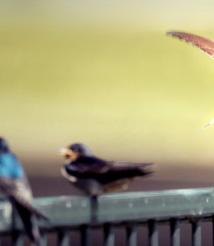
20 AUGUST (2) 2019 www.indianlink.com.au
VIEWFINDER
GURMEET KALSI
ethics of life and to me, a photographer, it can be quite a spiritual experience. Photographing wildlife takes moment. I had to commit a lot of time with these Welcome Swallows as they are very swift and fast moving birds, not start to flutter its wings as soon as the parent bird is around with the food in its beak. The shot was taken at fast (f8; ISO 1000; 1/1250 sec). and Tamron 150-600mm lens
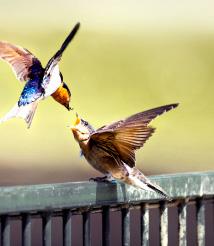
AUGUST (2) 2019 21 NATIONAL EDITION
Massive decline in India in coal power project lending
FA financial assessment this month has revealed a 90 per cent decline in coal power investment in India in 2018 compared to the previous year.
"Coal vs Renewables 2018" - an annual energy investment trend report - recorded a significant drop in lending to coal power projects compared to the lending received in 2017.
The report by the Delhi based financial institute Centre for Financial Analysis analysed project finance lending to 54 energy projects that reached financial close in 2018.
Of all energy project finance profiled in the study, 80 per cent went to renewables.
In 2018, only five coal power projects with a combined capacity of 3.8 gigawatt (GW) received finance totalling Rs 6,081 crore ($850 million).
By contrast, 12 coal-fired projects in 2017, with a combined capacity of 17 GW, received Rs 60,767 crore ($9.35 billion).
Similar trends were seen last year between public vs private banks and financial institutions, said the report.
Coal power project funding still dominates most of financial lending from public banks and a majority government owned financial institutions, whereas private banks and institutions continue to bet big on renewable energy (Rs 18,263 crore or $2.64 billion).
In 2018, some states clearly paved the pathway for renewable projects.
Projects in Karnataka, Madhya Pradesh and Gujarat attracted half of the entire country's project finance for renewables across 23 solar PV and wind projects.
As against these, Chhattisgarh and West Bengal together attracted project finance for three coal-fired power projects but no renewables.
Indian media, entertainment industry to hit Rs 3 trillion by 2024
Riding on the growing digital consumption via smartphones along with ultra-cheap data plans, the media and entertainment industry in India is likely to reach Rs 3.07 trillion by the financial year 2024, a new report said in mid-August.
According to KPMG's ‘India's Digital Future: Mass of niches' report, the media and entertainment industry posted a solid growth of 13 per cent during the financial year 2019 to reach Rs 1631 billion with a compound annual
growth rate (CAGR) of 11.5 per cent.
"With no major constraining factors, digital is expected to be a dominant force going forward and in FY23, it is likely to be the second-largest segment after TV and attract the highest marketing spend among all media formats," Girish Menon, Partner & Head Media & Entertainment, KPMG in India, said in a statement.
There are favourable factors for both digital access (smartphone penetration and low data costs) and content supply (investments in original and regional digital content), which together will continue to drive up online consumption.
The investments in regional content is an outcome of the growing importance of regional language markets in India. With the digital migration of English-speaking audiences almost complete, most new users coming online - and there are expected to be 500 million of them by 2030 - will access the internet in a local language, the report said.
The 500 million new users present digital businesses with an unparalleled market opportunity but not without some complexity.
Segmentation will become important as the market evolves into a ‘mass of niches’, the report said.
"Our initial hypothesis is that in 2030, the user will primarily be a non-English speaking, mobile phone user, from a developed rural area/non-metro urban setting who is increasingly willing to pay for content online," elaborated Satya Easwaran, Partner & Head Technology, Media and Telecom, KPMG in India.
The digital disruption has forced a pivot of business models in media and entertainment from an erstwhile B2B2C model to a D2C (direct to consumer) one.
"Therefore, segmentation and demographic, psychographic and behavioural profiling will all become increasingly important, as they have historically been in other consumer businesses," said Easwaran.
The television segment had a good year for the first three quarters of FY2019, but the challenges in implementation of the New Tariff Order (NTO) and the resultant uncertainty around viewership and subscription renewals affected both the advertisement and subscription revenues in the last three months of FY19.
The market size this year includes advertisement revenues of Rs 251 billion and subscription revenues of Rs 463 billion.
The print media industry survived ups and downs over a period of FY2018 witnessing a rough patch due to disruptions caused by the implementation of the new GST regime, RERA regulations and demonetisation with the lowest growth in a decade at 3.4 per cent.
According to the report, globally the print industry is on the decline but the Indian print industry continued to buck trends and grew at 5.6 per cent CAGR from FY15 to FY19.
We're growing at over 20% in India premium segment:
Samsung Samsung which logged 63 per cent market share (by value) in India’s premium smartphone segment in the first half this year, has registered over 2 times the pre-booking orders for its 'made in India' Note10 series smartphones compared to last year's Note9 pre-booking period, a top company executive has revealed.
The pre-booking for Galaxy Note10 was open for consumers in India on 8-22 August. Those who pre-booked will get their devices with special offers on August 23.
"We had 52 per cent value market share in the premium segment (over Rs 30,000) in full year 2018. In the first half of 2019 (JanuaryJune period), we have clocked 63 per cent value market share in the premium segment," Ranjivjit Singh, Senior Vice President and Head of Marketing, Mobile Business, Samsung India, told IANS on the sidelines of Note10 series launch in the country.
"Overall, the premium segment is estimated to be between Rs 15,000-Rs 20,000 crore in India. In this segment, the industry is growing at 9-10 per cent while we are growing in excess of 20 per cent in the country," Singh emphasised.
Samsung has just introduced the "made in India" Samsung Galaxy Note10 and Galaxy Note10+ with enhanced S Pen and pro-grade camera.
The 6.3-inch FHD+ Galaxy Note10 (8GB RAM+256GB memory and no microSD) is priced at Rs 69,999 while the bigger 6.8inch Galaxy Note10+ (12GB RAM + 256GB memory) with Cinematic Infinity Display will start from Rs 79,999.
The top-end variant of Note 10+ with 12GB RAM with 512GB internal storage (expandable up to 1TB) will be available for Rs 89,999.
"Not just Galaxy series, our A80 device that comes for Rs 47,990 has also created disruption in the over Rs 30,000 premium
An untitled graphite-on-paper by Amrita Sher-Gil fetched Rs 70 lakh ($145,000), and a water colour by MF Husain titled That Obscure Object of Desire sold for Rs 22 lakh ($45,000) at a high-end art auction by the Taj Group of Hotels in New Delhi, to mark the 115th anniversary of the company.


segment in India. We have got tremendous response for the device that has world's first 48MP rotating triple camera," Singh informed.
According to the latest International Data Corporation's (IDC) "Asia/Pacific Quarterly Mobile Phone Tracker", India’s smartphone market saw the highest-ever second quarter shipment of 36.9 million in the second quarter (Q2) this year.
Samsung registered a strong 16.6 per cent (YoY) growth in the second quarter, fueled by the newly-launched Galaxy A series across low and mid-price segments. Galaxy A10 and A2 Core have been among the top 5 models overall for the market.
Yamuna floods homes, thousands evacuated
With floodwaters of the Yamuna having swamped their homes, some 14,000 people have been moved to relief camps.
As monsoon rains pounded the upper reaches, neighbouring Haryana released water from the HathiniKund dam flooding the homes of those living near the Yamuna's banks.
Several farmers engaged in small-time farming near the Yamuna Khadar and Kisan Colony area in the national capital said they have lost all hopes of earning a livelihood with the rising Yamuna waters destroying their crops.
The Delhi government has set up 46 relief camps with 2,120 tents having electricity, water, food and toilets across the city.
Several people living in the area are refusing to move to the relief camps, preferring instead to come for meals and then return to their halfsubmerged houses.
The water discharged from the barrage - which provides drinking water to Delhinormally takes 72 hours to reach the capital, the official said.
The river flows through five districts of Delhi - North, North East, Shahdara East, Central and South East.
Mediterranean migrants in Himalayas: Roopkund bones study
Nestled deep in the Himalayas at 5,029 metres above sea level, Roopkund Lake is colloquially referred to as "Skeleton Lake" due to the remains of several hundred ancient humans scattered around its shores.
A study by an international team of scientists has now revealed that ancient DNA from mysterious skeletons found in and around the
22 AUGUST (2) 2019 www.indianlink.com.au INDIAN NEWS
Photo: IANS
The Chhatrapati Shivaji Maharaj Terminus Railway Station is illuminated on the anniversary of Indian Independence Day in Mumbai, 15 August 2019.

lake show Mediterranean migrants travelled to the Himalayas.
The study involving 28 researchers from institutions in India, the US and Europe revealed that the skeletons belonged to three genetically distinct groups.
The study, published in popular science journal Nature Communications, covered 38 skeletons found in Roopkund Lake and once thought to have died during a single catastrophic event. However, researchers found that they died in multiple periods separated by at least 1,000 years.
Genome-wide ancient DNA reveals that 23 of the individuals had ancestry that falls within the range of variation of present-day South Asians. A further 14 had ancestry typical of the eastern Mediterranean while one individual was found with Southeast Asian-related ancestry.
According to Hyderabad-based Centre for Cellular and Molecular Biology (CCMB), which was part of the study, it was the first ancient DNA ever reported from India.
"Little was known about the origin of these skeletons, as they have never been subjected to systematic anthropological or archaeological scrutiny, in part due to the disturbed nature of the site, which is frequently affected by rockslides, and which is often visited by local pilgrims and hikers who have manipulated the skeletons and removed many of the artifacts," says the study.
"There have been multiple proposals to explain the origins of these skeletons. Local folklore describes a pilgrimage to the nearby shrine of the mountain goddess, Nanda Devi, undertaken by a king and queen and their many attendants, who "due to their inappropriate, celebratory behaviour" were struck down by the wrath of Nanda Devi. It has also been suggested that these are the remains of an army or group of merchants who were caught in a storm. Finally, it has been suggested that they were the victims of an epidemic."
The researchers analysed the remains using a series of bioarcheologicaltests, including ancient DNA, stable isotope dietary reconstruction, radiocarbon dating and osteological analysis.
76 skeletal samples (72 long bones and four teeth) were sampled at the Anthropological Survey of India, Kolkata. Skeletal sampling was performed in dedicated ancient DNA facilities at CCMB in Hyderabad. A subset of samples were further processed at Harvard
Medical School, Boston.
Only Sanskrit daily newspaper struggles to survive
As the country celebrated World Sanskrit Week to popularise the "language of the gods," which previous External Affairs Minister, the late Sushma Swaraj, claimed was a modern language fit for computers, the only Sanskrit daily of India, Sudharma, published from Mysore, is struggling for survival.
Economics apart, the number of patrons of this newspaper, celebrating its 50th anniversary, is dwindling. The management has now sought help from various government agencies which have shown little interest so far.
Sudharma was started by Pandit Varadaraja Iyengar, a Sanskrit scholar, in 1970, to reach out to those who loved the language and were interested in promoting it. These days, his son K.V. Sampath Kumar and his wife Jayalakshmi are continuing to keep the legacy alive.
The newspaper, an-A3-size, two-page and five-column-sheet, has around 3,000 subscribers, mostly institutions and public libraries, who receive the copies by post. The e-version has around 100,000 readers.
While newspapers in Hindi and other languages continue to do well, Sudharma seems to have run out of resources.
"That's because no state or central body comes forward to assist us in any way and the response from various organisations in the private sector is indifferent," says editor K.V. Sampath Kumar.
Jayalakshmi, who is well versed in Hindi, Tamil, Kannada, and English, believes Sanskrit is a great language. People use it from birth to death for conducting Vedic rituals and religious ceremonies right across the length and breadth of the country.
“India is united by Sanskrit, which is the mother language sustaining so many languages in the country. It is growing, and now, even IT professionals are finding it is useful,” she said.
Priced at Rs 1.75, the paper mostly contains articles on Vedas, yoga, religion as also on politics and culture, among others. Sudharma's modest office in Ramchandra Agrahara has been visited by Ministers, Governors, Shankaracharyas, and other dignitaries.
Being the Sanskrit and Yoga capital of India, Mysore has a fairly good strength of scholars. Interest in Ayurveda and alternative medicines has also led to an increase in the demand for Sanskrit learning centres.
Scholars say Sanskrit was considered the
"language of the gods" in India. Despite the contribution Sanskrit has made to Indian philosophical and literary traditions, vested interests have spread the impression that the language is dead, inaccessible and of negligible relevance to daily life. This is far from true.
For the publishers of Sudharma, the newspaper is not so much a profitable venture but a mission, and a demonstration of love for the language which is now gaining international recognition.
Sampath Kumar was honoured this month by the HRD Ministry for his contribution to the Sanskrit language at a function in New Delhi organised by the World Sanskrit Sansthan.
Rest in peace, Vidya Sinha
She was the girl next door for an entire generation of Bollywood fans. Long before Vidya Sinha became a household name for Gen Now viewers playing the soap grandma on shows such as Kkavyanjali, Qubool Hai and Kullfi Kumarr Bajewala, she rose to unlikely stardom in the seventies. In an era when the Bollywood heroine was getting a dash of emancipation and westernised oomph, Vidya was the sari-clad Bharatiyanaari who exuded resolve and resilience on screen.
Vidya Sinha was an exception in Hindi commercial cinema for more than just that. She was unconventional in her choices in life as well as career, and the way she balanced both. She was already married when she shot to stardom doing Rajnigandha in 1974, having married Venkateshwaran Iyer in 1974. The couple remained married till his death in 1996. Which means Vidya remained married all through her heydays as a star - something unthinkable back in the seventies, when actresses were known to marry in secret, since a marital status becoming public could affect stardom.
The quintessential Indian woman she represented became her USP, and she found ready roles in the genre of middle-of-theroad cinema, the seventies equivalent to the new-age multiplex movie, made on medium budget and flaunting no superstars, but banking entirely on content. Basu Chatterjee, a connoisseur of the genre, frequently cast her in his films.
Chatterjee's cinematic idiom blended humour with gentle drama that reflected a socio-cultural comment on the times and its people. Vidya, with her believable image as a girl next door, became a talisman of sorts for the filmmaker's works, along with actors as
Amol Palekar and Sanjeev Kumar, who also exuded a similar image of realism through their acting.
Vidya and Amol Palekar saw hits such as Rajnigandha (1974), Chhoti Si Baat (1976) and Safed Jhooth (1977). With Sanjeev Kumar she had two major hits in 1978, the family drama Tumhare Liye and BR Chopra's comedy Pati Patni Aur Woh.
The seventies in fact marked Vidya's top form. In 1977, she balanced a realistic entertainer as Gulzar's Kitaab (1977) with Raj N. Sippy's action thriller Inkaar, starring Vinod Khanna and based on Akira Kurosawa's High And Low.
Vidya Sinha is still recalled for her natural style of acting, in an era when being over-thetop with histrionics was considered the badge of success in commercial Hindi cinema. She owes her ease before the camera probably to two factors - she was born in a film family, and had a brief stint of modelling before entering films.
Her father was the screenwriter and producer Rana Pratap Singh, popularly known as Pratap A. Rana, who made films such as Parwana (1947), Vidya (1948) and Jeet (1949).
Her run-up to modelling was an outcome of being crowned Miss Bombay. The victory brought offers from several brands in its wake.
It was during this phase that Basu Chatterjee spotted her and cast her in his 1974 film Raja Kaka opposite Kiran Kumar. By the time he cast her again in Rajnigandha later in the same year, Vidya was already a star.
Not many know Vidya had a small role in Satyajit ray's 1962 classic Kanchejungha. She made a mark in a career where she played the heroine over just about 12 years.
By the eighties, trends were changing, and she had to find room for experimenting. An interesting departure in terms of image was Raj N. Sippy's 1981 action drama, Josh, which cast Vidya in a negative role.
Vidya's last prominent release on the big screen was the Salman Khan-starrer Bodyguard in 2011, where she had a supporting role. Lately, she had been one of Indian television's favourite screen grandmothers.
Realising her space in Bollywood was shrinking, Vidya gave it all up by the nineties. In 2001, she went for a second marriage with an Australia-based doctor named Bhimrao Salunkhe. The couple got divorced in 2009, after Vidya complained of domestic abuse.
IANS
AUGUST (2) 2019 23 NATIONAL EDITION
Photo: AP
WHAT’S ON
COMMUNITY
Gandhi at 150
23 Aug (4:00pm onwards) The Consulate General of India Sydney, the International Centre for Nonviolence Australia and Soka
Gakkai International Australia
commemorate the 150th anniversary of Mahatma Gandhi at SGI Australia Culture Centre, 3 Parkview Drive, Sydney Olympic Park.
Details Gambhir Watts 9283 6088
Punjabi Khed Mela
Sun 25 Aug (9.00am onwards)
Punjabi League of Aus (Inc) presents the sports meet Punjabi Khed Mela at Exeter Farm Reserve, Meurants Lane, Glenwood. Features include Kabaddi, volleyball, soccer, athletics, khokho and special events for women and children. Details
Makhan Singh Hayer 0410 462 855
ART
‘Storing & Remembering’
21 - 31 Aug Mother-daughter artist duo Panchali Sheth and Nikita Sheth present the exhibition ‘Storing & Remembering’ based on their shared interest in capturing the ideas surrounding forgetting and remembering; permanence and absence; and love and loss. Taking memory as a common point of departure, both artists create works that express something innately personal from their past: an experience, a conversation, a smell, a connection. Location: Sheffer Gallery, 38 Lander Street, Darlington, Sydney.
Details 02 9310 5683
STAGE
Master Saleem Live in Concert
Sun 25 Aug (5:00 pm onwards)
Bonnyrigg Sports Club 618 Elizabeth Drive Bonnyrigg Heights, NSW.
Details 0423 273 621
Tishani Doshi
Tue 27 Aug (6.30pm - 8.00pm)
Critical Path presents Tishani Doshi in conversation with First Nations choreographer and dancer Amrita Hepi. Part performance, part video, part talk, this is an intimate evening with Indian contemporary dancer
Tishani Doshi. Location: Parramatta
Artists Studios, Level 1 & 2, 68 Macquarie St, Parramatta.
Details 02 9806 5230
Punjabi Virsa
Sat 31 Aug (7:00 pm onwards)
Punjabi Virsa 2019 Live In Concert at Diamond Showroom, Blacktown Workers Club, 55 Campbell St, Blacktown. Details 0452 337 387
Stand-up comedy:
Jagan Krishnan
Sat 31 Aug (6:30pm onwards) Tamil comedy act Jagan Krishnan at Yaarl Function Centre, 221A Wentworth Ave Pendle Hill.
Kolkata’s Chandrabindoo
31 Aug (6.00pm onwards) Famed
Kolkata band Chandrabindoo, brings to Sydney its satirical take on sociocultural issues in “Ban Bhashi”.
Venue: C3, M108 Silverwater Rd, Silverwater.
Details Taneem 0406 063 058
ENTERTAINMENT
The Asli Gully Boy, Rapper Naezy
Sat 24 Aug (9:00 pm onwards)
Gully Boy fame rapper Naezy Live in Sydney at IVY Level 2, Den, Lounge & Terrace, 330 George St, Sydney.
Details 0425 253 465.
Garba Night Devang Patel
Sat 7 Sept (7:00pm onwards)
Blacktown Leisure Centre, Stanhope Parkway and Sentry Drive, Stanhope Gardens.
Details Shah 0425 188 199
Fashion Show: Royal Indian
Rendezvous
Sat 21 Sept (12:00 noon to 05:00 pm) Bowman Hall, 35 Campbell Street, Blacktown.
Raas Leela with Parthiv Gohil Sat 14 Sept (6:00pm – 11:00pm) Blacktown Leisure Centre, Stanhope Parkway and Sentry Drive, Stanhope Gardens. Details 0411 964 506
Dandiya Night with Fashion Show
Sun 29 Sept (5:00pm – 9:00pm)
Team India present a Dandiya night with live band and traditional fashion show, with indoor activities for kids.
Venue: Young St, Parramatta.
Details 0470 130 891 or email teamindia.au@gmail.com
CLASSICAL
Abhijnana Shakunthalam
Sat 12 Oct (6.30pm onwards) To celebrate Diwali this year, charity organisation Vision 2020 has organised a grand ballet based on the great Indian poet Kalidasa’s immortal drama Abhijnana Shakunthalam. Exclusively choreographed by Sydney’s renowned artist Hamsa Venkat and presented by Samskriti School of Dance, it will be a rich cultural experience for all age groups. Venue: Performing Arts Centre, Pacific Hills Christian School, 9-15 Quarry Road, Dural. Fresh food and free parking available. This year Vision 2020 is supporting a unique organisation REHOBOTH (Shelter) Paraniputhur in rural Tamil Nadu, which has been providing shelter and rehabilitation facilities to destitute women with mental health issues.
Details www.Vision2020.org.au
Carnatic music: Vignesh Ishwar
Sun 15 Sept (4.00pm – 7:30pm)
Pallavi Sydney presents Carnatic vocalist Vignesh Ishwar, accompanied by K Praveen Kumar on mrudangam and L Ramakrishnan on violin. Venue: Ermington Community Centre, 10 River Rd, Ermington NSW. Details Mohan Ayyar 0407 398 267
STUDENTS
Essay writing competition
The Ambedkar International Mission Australia invites entries for its second annual essay writing competition, open to uni students across Australia and New Zealand. Topics:
1. Comparison of Dr Ambedkar’s contributions with any political philosopher of your choice OR
2. Salience of Dr Ambedkar in the coming decade in any one of the following aspects – Social justice, Affirmative action, Women’s empowerment, Nation building. 3000 words. First prize $300. Second prize $200. Third prize $100. Last date for submission 15 Nov 2019. Submit entries to aim.sydney2018@gmail.com.
Details Vaibhav Gaekwad 0415 469 525
FESTIVAL
Janmashtami
Sat 24 Aug (6:30pm – 9:30pm)
Divine & Holistic and Australian School of Meditation & Yoga present Sri Krishna Janmashtami at Granville Town Hall, 10 Carlton Street, Granville. Featuring one of Australia's leading kirtan bands Ashraya.
SENIORS
Seniors Rights Forum
Sat 24 Aug (1.00pm – 4.00pm)
AASHA Foundation Australia (Ltd) announces a forum on ageing and seniors rights, including Q and A with experts and free health checks. Venue: Wentworthville Community Centre, 2 Lane St, Wentworthville. Details Bijinder Dugal 0412 786 569
Seniors meet-ups
AASHA Foundation Australia (Ltd) organises seniors social hubs at various centres across Sydney. Allcommunities welcome. Activities include yoga, music, dance, networking, health talks, technology, health checks, light lunch.
Blacktown: First Wednesday of the month (11.00am – 2.00pm) Westpoint Shopping Centre, 17 Patrick St, Blacktown (Community Room, next to gym, Fourth floor). Close to railway station.
Wentworthville: Fourth Saturday of the month (12.30pm – 4.30pm)
Wentworthville Community Centre, Grevillea Hall (next to library), 2 Main Street, Wentworthville. Close to railway station
Hornsby: Second and Fourth Friday of the month (11.00am –2.00pm) Hornsby Youth & Family Community Centre, Cnr. Muriel and Burdett St, Close to railway station. Crows Nest: Third Wednesday of the month (10.00am – 11.30am) Musicbased social gathering at Crows Nest Centre, 2 Ernest Place, Crows Nest.
Details Bijinder Dugal 0412 786 569
YOGA
AND
MEDITATION
Lunch-time yoga and meditation
Mondays Art of Living Sydney presents free lunch-time Yoga
sessions from 12:30 pm - 1:30 pm at Level 2, 265 Castlereagh Street, Sydney.
Thursdays The Brahma Kumaris Australia present meditation sessions from 12.15pm - 1.00pm at the Indian Cultural Centre, Level 2, 265 Castlereagh Street, Sydney. Details 02 9223 2702 Register at icc2.sydney@mea.gov.in
Yoga at Spirit of India
Saturdays and Sundays, 15-week Yoga course. Also check out special yoga classes for children (5-12 years), adults and senior citizens (55 plus). Venues at Wentworthville, Quakers Hill, Pennant Hills, Auburn, Epping, Homebush, Ryde.
Free Yoga class every Wednesday (5.30pm - 7.00pm) at Indian Consulate Cultural Centre, Level 2, 265 Castlereagh St, Sydney. Free meditation every Saturday (8.30am9.15am) at Wentworthville. Details www.spiritofindia.org or call Suresh 0412 202 182 or Raja 0402 789 109
SPIRITUAL
Swami Sadyojathah
Sat 24 Aug (4:30pm - 7:30pm)
The Art of Living Foundation presents an evening of music, wisdom & meditation with Swami Sadyojathah, the royal that became a humanitarian worker.
Venue: Canada Bay Club, 4 William Street, Five Dock. This is a free event. As places are limited, RSVP required by 20 Aug. Email: amrita.in@gmail.com
Chinmaya Mission Australia
Saturdays Family programs (Balvihar classes) at Eastwood (3.00pm - 4.15pm) and at Strathfield (4.45pm - 6.00pm). Details
Chinmaya Sannidhi 02 8850 7400, 0416 482 149
Sant Nirankari Mission Sydney weekly congregations
Sundays (5:30pm - 7:30pm) followed by community meals. Venue: Sant Nirankari Bhawan, 166 Glendenning Road, Glendenning. Details Devinder 0403 216 084
EXHIBITION
Archibald Prize 2019
Until 8 Sep Check outAustralia’s most extraordinary art event that awards the best portrait artists for their paintings. South Asian artist Ramesh Mario Nithiyendran and Young Archie finalists Lakshman Nitish Ramesh and Anupama Pangeni are hung in this year’s event. Also hung is a lovely portrait of iconic restaurateur Anant Singh who opened the famous Jasmin restaurant in Adelaide in 1980. Venue: Art Gallery Rd, Sydney NSW 2000.
Details 1800 679 278
To add your notice email media@indianlink.com.au
24 AUGUST (2) 2019 www.indianlink.com.au
When an engineer turns baker…
… the cakes get a bit of movement
 BY NANDITHA SURESH
BY NANDITHA SURESH

What kind of a birthday cake would you make for a Luna Park obsessed teenager?
A Ferris wheel cake would bring the house down, right?

Well, what if you put a motor in it and actually made it rotate?
That’s exactly what Melissa Domingo Rawat did for her 16-year-old nephew recently.
The Luna Park-inspired deliciousness was anything but an ordinary chocolate and peppermint cake. It turned out to be an artwork with sculpted edible elements, its star feature a moving Ferris wheel comprising chocolate and salted caramel popcorn cupcakes as passenger cars.

“It was truly a coming together of my engineering background, art and my love for baking,” Melissa shared proudly.
Stirred by passion, combined with a natural gift for art, and generously seasoned with a love of good-tasting cakes, home baker Melissa’s creations are a thing of marvel.
Whimsical cakes, especially those with moving parts, are a particular specialitythanks to her background in electrical and electronics engineering.
“In the Ferris wheel set up, the motor as such is an AC motor
preferred to use an AC motor so there’s no chance of running out of power, as might well be the case when using batteries.”
The Sydney mum of two is no stranger to cakes and cookies. She grew up with a mum who loved to bake.

“I come from an Anglo-Indian family in Hyderabad and baked goodies were a weekly affair,” recounted Melissa. “They were simple yet moreish treats that didn’t come with the fancy colours or designs, but I was
Melissa made her own first cake as an 8-year-old; little did she know a career of making all things delicious was awaiting her. It was not just baking that was the core of the young Melissa’s life. She claims to have been “always fuelled by art in its various forms”.
“Music and art have always been other great loves.
Yet, like many Indian kids, I was taught the importance of being careerfocused, so I put my interest
in arts on the backburner.”
Even while being a busy career woman, she never let her artsy side rest completely. She would always make time for things she loved.
Moving to Australia and becoming a mum, Melissa took to freelance work as child-rearing responsibilities took precedence. As her youngest starts school next year, she is keen to get back in a technical role, but for now, the lady who wears many hats has converted her passion for cakes into a profession,launching a home baking business aptly named Baker Mum.
Making delicious cakes comes naturally to Melissa but turning it all into a business was never part of the plan. “I’ve been disappointed one too many times by commercially available cakes,” Melissa
shared. “They were always either too dry, too sweet or just not as tasty as I’d like them. Something was always missing.”
So, she started making her own, for her children’s birthdays, and for friends and family. They were always loved and got rave reviews. A gentle nudge from friends who suggested Melissa should be selling her baked goods, was the icing on the cake. Thus began the Baker Mum’s journey. Melissa has since baked and sold sweet goodies ranging from simple to intricate, and treats for special dietary needs. While she is a self-confessed lover of classic cakes, she doesn’t shy away from experimenting with techniques, and her degree in engineering comes in handy too. The Luna Park and Ferris wheel cake, which gave 30 portions, wasn’t the first time she took on a cake-making challenge with the works. A spinning disco ball cake for her daughter’s dance-themed birthday party, has been another highlight.
“Another cake I am particularly proud of, is a 75th birthday cake for a marathon runner,” she recalled. This one didn’t have any moving parts, but it was created to look like a runner’s pair of muddy sneakers.


Her impressive portfolio of cakes includes a realistic looking Dairy Milk bar, which could be snapped off and not cut like a real bar of chocolate; a drum set, and several themed and tiered cakes.
However, she’s not just all about Pinterest-worthy cakes; admittedly she enjoys making and savouring simple cakes which are all about the flavour. “I am very fussed on the quality regardless of the scale of the order. I only ever use the very best ingredients and don’t cut corners on quality,” she noted.
Small or big, simple or grand, the Baker Mum enjoys a challenge.
“It’s the greatest feeling to see an idea come to life in an edible form, but the ultimate joy for me is when the customer is wowed,” revealed Melissa.
We hope her baking adventures continue to sweeten many more special occasions.
ENTREPRENEUR







26 AUGUST (2) 2019 www.indianlink.com.au
THIS MONTH SEND YOUR EVENT SNAPS OR PARTY PICS TO MEDIA@INDIANLINK.COM.AU
Manjit Gujral hosts the premiere screening of SBS documentary Turban Legend: Untold Australia at his restaurant Manjit’s on the Wharf. He is seen here with producer Jennifer Cummins, wife Kanwal and sons Deep and Varun
PEOPLE, PLACES, PARTIES
Happy 21st, Alina Alikhan!
Poonam Chandiramani celebrates her birthday with friends
A private birthday dinner for Anshika Maini, seen here with husband Vineet
AUGUST (2) 2019 27 NATIONAL EDITION Diwali Art Competition Design INDIAN LINK’S Diwali card and TWO categories: Kids up to 7 years, Kids 8-12 years. WIN PRIZES! WIN book vouchers valued at $75 and $50 in both categories. PLUS The winning entry will be designed into Indian Link’s Diwali cards for the year 2019. For more details, ring the Indian Link office on 02 9290 1855, or email media@indianlink.com.au USE THIS DESIGN AS A TEMPLATE TO COLOUR IN OR PAINT A MANDALA. PHOTOCOPY IT IF YOU NEED TO. Send in your work, along with your name, age, address and phone number, to: Indian Link, GPO Box 108 , Sydney 2001. Last date for submission 1 Oct 2019 LINKING INDIA WITH AUSTRALIA MEDIA GROUP
Out of our yearning
BY SMRITI SEKHAR
Can you #relate to the following situations? Grocery shopping with your parents in Indian supermart aisles lined with pickle bottles, masala boxes and frozen vegetable freezers, or perhaps scrolling through Subtle Curry Traits whilst silently chuckling to yourself in response to every meme?
Well, mate, you’re an Indian-Australian millennial.
We’re a unique cross-section of Australian demographics that embrace our Bharatiya sanskriti (Indian culture) as well as we celebrate our true blue, fair dinkum Aussie selves.
At a recent event entitled Unspoken, I watched the lived experiences of IndianAustralian millennials brought to life through the creative and performing art mediums of drama and dance. Produced by the youth chapter of the Marathi Katta Australia (MKA), it turned out to be a true blue ‘paisa vasool’ Bollywood filmgoing experience. Charged with the power of using goodwill to achieve a shared goal, the youth organisation’s effort to achieve their parent organisation’s vision of assisting public benevolent activities and disadvantaged people without discrimination, was heartening.
Written and directed by Ashutosh Dhar and Rangan Balakumar, the musical theatre spectacle explored the journey that the protagonist (Aryan) takes towards selfrealisation and identity discovery, through the experiences of his Indian-Australian friendship group with Maya, Paras and Rohan. Both the quartet’s individual and collective struggles and successes were enacted to reach a poignantly profound ending.
The play also delved into the uncertainties and anxieties that accompany


being different to others, as Aryan is revealed as being a person with special needs. His inner monologue is personified as Pingu, as his extensive knowledge on penguin species provide the audience an insight into his stream of consciousness.
The departments of music, costume, set, dance and direction coordinated seamlessly to create a richly woven tapestry of a musical theatre experience. Like in every good ‘paisa vasool’ masala film, I was moved to laugh and shed tears by the playful yet poignant story telling.

The dramatic aspects were in the hands of highly capable young adult actors who graced the stage with their expressions, stances and voice work. Actors who delivered Hindi/Marathi words in their dialogues nailed their pronunciation and incorporated classically Indian expressions making an authentically accurate portrayal that was incredibly satisfying to watch.
The dance portions of Unspoken were similarly impeccable. A pivotal part of

any musical theatre, the items were well interjected through the runtime, providing thought-provoking visual aesthetics. Though the songs were familiar to a keen Bollywood buff, both the choreography and execution were fresh and adeptly performed by the cast members. During Rohan’s dance sequence to Bezubaan, the dichotomy of the corporate theme and creative theme was emphasised through the adjacency of hip-hop and contemporary movements, respectively.
Whilst all members of the cast deserve acclaim for their portrayal of their characters, I would like to especially mention the protagonist Aryan for his keen, sensitive and well-researched essay of a character with special needs. The sheer attention to detail this actor paid to his role moved me greatly. As a teacher who has worked closely with students in Support Unit classes, I see first-hand the social-emotional struggles that children with special needs face as they navigate
the course of their life in this big world. To see Aryan being taken care of by his inner ‘waddle’ of friends and family as they take on ‘Life’ with him in the spirit of good-will and solidarity, was an incredibly special viewing experience for me as both an Indian-Australian millennial and a teacher.
I left Casula Powerhouse Arts Centre buzzing with the warmth of the positivity I had just experienced. The community spirit assembled by MKA Youth to produce this show was reminiscent of this quote from the Robin Williams-starring film Dead Poets Society:
"To quote from Whitman, 'O me! O life!... of the questions of these recurring; of the endless trains of the faithless... of cities filled with the foolish; what good amid these, O me, O life?' Answer. That you are here - that life exists, and identity; that the powerful play goes on and you may contribute a verse. That the powerful play goes on and you may contribute a verse. What will your verse be?"
28 AUGUST (2) 2019 www.indianlink.com.au STAGE
The vibrant spicy-sweet Indian-Australian millennial experience is brought to life in youth production
During Rohan’s dance sequence to Bezubaan, the dichotomy of the corporate theme and creative theme was emphasised through the adjacency of hip-hop and contemporary movements, respectively.
An outsider’s view of Tamil
Israeli Indologist presents a complex but delightful read of the history of the Tamil language

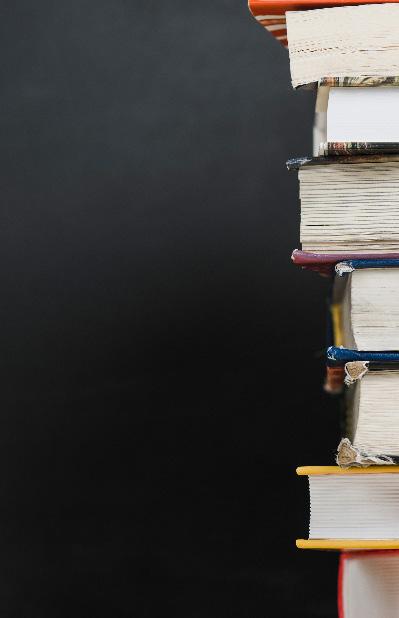 BY CHITRA SUDARSHAN
BY CHITRA SUDARSHAN
It was quite by accident that I stumbled upon a prodigious and erudite scholar of Indiaespecially southern India, during a recent trip to India. The book in bright orange titled Tamil: A Biography beckoned to me from the bookshop display shelves. As I began thumbing through, I was drawn irrevocably into it and found myself searching for and devouring books by this scintillating Iowa-born academic who had made Jerusalem his home, and on the way learnt and mastered several Indian languages and their literature.
David Shulman has written a series of deeply scholarly and engaging books on southern India. However, his magnum opus is Tamil: A Biography (Harvard 2016), a detailed account of one of the few ancient languages that has survived more than two millennia in more or less its original form among its 80 million speakers scattered around the world. Shulman even traces some words in the Hebrew Bible that have Tamil origins!

Some broad and distinct time periods emerge from Shulman’s history of Tamil. The first and historically pivotal period is the one of consolidation of Tamil’s very unique mode of speaking, writing, singing and thinking, beginning with the earliest extant work Irayanar Akapporul right up to the Sangam period marked by such great works as Silapadikaram. The early chapters are filled with delightful verses and prose translated from several ancient texts by the author, and numerous renditions of the lives and words of sages, poets, scholars and even Gods who elevated Tamil to its exalted status.
The second ‘blossoming’ occurred at the time of devotional outpourings of Vaishnava Alwars and Saiva Nayanmars, which in Shulman’s

influence as a shaping force within Hinduism. After throwing light on the Vaishnava saint Nammalwar, the author of the ‘Tamil Veda’, Tantric Bhakti saint-poets, and the role of Saiva Siddhanta mutts in the Kaveri delta, he emphasises their role in delinking the language from Brahmanical moulds -and in unleashing popular devotion in the vernacular in the whole of India. Saint-poets Andal and Karaikkal Ammaiar shine almost as early feminists!
The book then describes three centuries of Chola-era globalisation and the spread of Tamil beyond southern India to south-east Asia and China as the language used by merchants and monks (one can find evidence in the large number of Tamil words in Malay and Bahasa).
Kamban’s Ramavataram, seminal Jain and Buddhist works such as Seevaga Chintamani and Kundalakesi-give us a glimpse of the syncretic culture of the times and the contribution of these religions to Tamil.
Shulman demonstrates convincingly - contrary to popular misconceptions - that the post Chola period, between the 13th and the 16th centuries, was one of ‘continuous creative experimentation’ citing the works of Kalamega Pulavar, and the emergence of a synthetic register Manipravalam in southern Indian languages, a complex synthesis of Tamil, Telugu Malayalam and Sanskrit. Through his examination of such Kovil Ozhugu or Temple Register of the Srirangam temple, and record keepers and local historians such as the karnams, he demonstrates that contrary to colonial and popular misconceptions, there existed a rich corpus of written material and record of history in southern India.
Shulman falters when he tries to grapple with the emergence of Tamil modernity, although he pays rich tribute to U Ve Saminatha
Aiyar, who along with other scholars rediscovered lost texts in the 19th century, and







made it possible for us to access those ancient treasures today. He omits several renowned modern Tamil authors and poets. That aside, it is impossible not to be impressed by his scholarship and research overall. What Shulman demonstrates clearly is that the classical languages of southern India have been intimately interwoven for centuries. A pure, autonomous Tamil never existed, he argues, and warns against using such notions for political ends. The reality is that both Sanskrit and Tamil have jostled with, and borrowed from each other over the ages: one need only cite the examples of Sage Agastya who is said to have brought Tamil from the Himalayas; the great poet Dandin who is said to have bridged the language gap between Sanskrit and southern Indian languages in the Sangam era; the 17th century Tamil Saiva saint Kumaraguruparar, who went to Kashi to reinvigorate Saivism there, and became a Sanskrit scholar in the process.
One feels that this book needs to be read by all Indians, not just Tamils - for there is a lesson in this for politicians from northern India as well: when they read books such as this, they will, hopefully, develop an understanding of Tamil language and history, and an empathy for the sentiments of a people who have preserved and nurtured with love, their mother tongue through more than two millennia, and why they are passionate about it.
However, I fear it is not one that is easily accessible: it employs complex language and academic concepts that may put off most readers. My fear is that, sadly, not many will read it. Hopefully Shulman can bring out a simplified and condensed version of this book for lay readers worldwide.
NATIONAL EDITION BOOKS
Shulman demonstrates that contrary to colonial and popular misconceptions, there existed a rich corpus of written material and record of history in southern India between the 13th and 16th centuries.
Music maestro of classical allure



VINAYAK CHAKRAVORTY on the creative genius of Khayyam
When living legend Lata Mangeshkar tweeted to describe music maestro Khayyam’s demise as the "end of an era", she said it all. Khayyam’s music, soaked in the spirit of rich classical allure, represents the sort of melody unthinkable in Bollywood mainstream nowadays - inherently Indian melody that celebrates the sounds and culture of the soil.
Come to think of it, even in the era when he created music in Bollywood, his adherence to classicism made Khayyam an exception. Through the sixties, seventies and eighties - his busy years - Bollywood was discovering the sound of music coming from the West. Ever the puritan, and never inclined to filch a note from western influences, Khayyam's oeuvre had to be restricted to films that offered scope for Indian notes.
Not surprisingly, the first film that comes to mind when you talk Khayyam is Umrao Jaan, Muzaffar Ali's lavish costume drama of 1981, which won the composer a National Award for Best Music Direction. The success of Ali's arthouse gem has always been attributed to two factors primarily - the gorgeous Rekha's careerdefining performance as the eponymous courtesan and Khayyam's songs, brought alive with haunting charm by Asha Bhosle.
Ghazals, thumris, dadras and other genres of Hindustani classical music were Khayyam's forte. In an era when orchestra pop reigned, Khayyam was what many in Bollywood referred to as an artiste of refined expertise. He revelled in composing songs in intrinsically Indian genres for films such as Anjuman (1986), Razia Sultan (1983), Bazaar (1982), Dil-eNadaan (1982), and Noorie (1979).
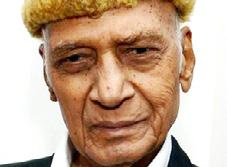
His classical flair prompted the legendary Meena Kumari to approach Khayyam to score music for her album, "I Write, I Recite", where she sang her own poetry.
But Khayyam was equally effective scoring simpler tunes that complimented the poetry of Sahir Ludhianvi in Kabhi Kabhie and Trishul, or Gulzar in Thodisi Bewafaii. These films went on to become musical hits.

Khayyam was a creative genius who left his mark quietly, much like the subtle art he created in the recording studio. Clearly, his contribution mattered more than just as music composer in Bollywood. His initiative to take essentially Indian music to the masses to the films he composed for, saw him being conferred with the Sangeet Natak Akademi Award and a Padma Bhushan in his lifetime.
The mild-mannered genius may have breathed his last at Sujoy Hospital in Mumbai's Juhu area, where he was admitted for around 10 days following a lung infection, but his body of work will
continue to resonate.




Indeed, if his filmography looks like the legacy left behind by a master today, his early start as a musician probably accounts for as much. Khayyam began music direction at the age of 17 in Ludhiana.

At 18, his musical dreams were briefly halted. World War II was on, and Khayyam enlisted in the Army. It was only three years later that he landed in Mumbai, to continue with his musical journey.
There is an interesting anecdote here. He started off composing as Sharmaji of the Sharmaji-Varmaji composer duo, which created music for the 1948 film Heer Ranjha. His partner, Rahman Varma, however, left Bombay after Partition.

Five years on, it was time for Khayyam's solo break. He scored for the 1953 hit Foot Path, starring Dilip Kumar and Meena Kumari. Although Timir Baran was credited as the primary composer of the film, its success, and Khayyam's natural tendency to thrive with classical notes, impressed all. The rest, as they say, is history. Early hits included songs in films such as Phir Subah Hogi (1958), Shola Aur Shabnam (1961) and Aakhri Khat (1966) - the last mentioned marking superstar Rajesh Khanna's entry into Bollywood.
Expressing condolence, Prime Minister Narendra Modi noted two very significant aspects that mark the master composer's identity. First, he said, "India will remain grateful to Khayyam Sahab for giving us some of the most memorable compositions, which will be remembered forever". Secondly, he observed that Khayyam would "also be remembered for his humanitarian gestures to support upcoming artists".
Khayyam was a genius with a large heart, which genius became evident in 2016 when composer and his singer-wife Jagjit Kaur established the KhayyamJagjit Kaur KPG Charitable Trust, in the memory of their son, the late actor Pradeep who passed away six years ago. The couple gave away all their earnings to the cause of upcoming artistes and technicians of the film industry.
Mohammed Zahur Khayyam Hashmi - Khayyam to the world - was 92 when he breathed his last. His unforgettable legacy will surely outlive that physical life span.
30 AUGUST (2) 2019 www.indianlink.com.au
TRIBUTE
Loving right now
A list of Indian Link’s current favourites


READ
In 1859, Australia’s first native-born novelist John Lang wrote Wanderings in India and other Sketches, an entertaining travel book. Having practiced law in India (Lang’s clients included the Rani of Jhansi), starting a paper in Meerut and ultimately dying in Mussoorie, Lang and his book (or at least, the title of his book) are the inspiration behind Monash University’s collection of essays titled Wanderings in India: Australian Perceptions, published in 2012. Part historical, part sporting and political, this one’s a really cool travel accessory if you’re Indian, Australian or anything in between!

LISTEN
Deserve Me is the debut single of Amritha Shakti, the Australian/Indian singer-song writer, who for years has been covering a range of songs across genres including jazz, R&B, soul, Indian fusion and Bollywood. A celebration of South Asian women, the video for Deserve Me is gloriously filmed and features around 30 South Asian womenfrom Pakistani, Indian, Sri Lankan, Nepalese and Bangladeshi backgrounds. Amritha’s familiar and compelling backstory, the video’s stunning visuals and her rich, husky voice make this lovely (and catchy) single a great soundtrack to a wistful winter evening.
EAT
Only a few steps away from the restaurants on Wigram St in Harris Park, sits this little hole-in-the-wall eatery, Shri Refreshment Bar. Stand by and watch the rotis fluff up, on a large open hot plate. We make about a thousand each, nightly, the girls tell you smilingly. The phulkas and stuffed parathas entice you in, but before you leave, you’ll have tried the street food favourites kachori chaat, matka rabri and masala chai, and Shri’s signature paan. Our top pick? Chapatis straight off the tava with two home-style curries, under $10.
WATCH
Long before there was the shady Guruji (Sacred Games2) or even the utter nut job Charles Manson (experiencing a brief pop culture revival thanks to Mindhunter season 2 and Once Upon a Time in Hollywood), there was the OG holy man with his cult following – Bhagwan Rajneesh aka Osho. ICYMI, Netflix’s 2018 docu-series Wild, Wild Country is a brilliant deep-dive into all things Osho, especially the maroon robe-clad “Rajneeshes” (his followers), with particular focus on the nearly-murderous antics of Ma Anand Sheela and an unwitting Australian Jane Stork. Binge score = 10/10!

AUGUST (2) 2019 31 NATIONAL EDITION CULTURE DIARIES
cineTALK
Saif and his estranged wife where he begs her to return to his lonely life. Saif moves around with a bloodied severed thumb, and I wondered if that thumb is indicative of the wounded city of Mumbai.
There is more bleakness and wretchedness. I couldn't see a single happy character in the entire length and breadth of the series. No one laughs except to mock another. The humour, if it can be called that, is incredibly cheerless. Gainkonde in Mombassa, tells the hot-headed Bunty (Jatin Sarna) in Mumbai, he is gone off to the moon.
Bunty's gaze goes up in the sky. LOL.
Even the new characters of Season 2 are up to no good, for themselves or others.

Pankaj Tripathi as a cryptic guru has the most interesting lines and a character that spreads itself out gradually into a bewildering arc of demoniacal destruction. The tension, built organically into the plot of season one, seems forced here and shoved into a landscape that is as barren as an artificial grass carpet spread in a high-rise living room.
VILE AND VENOMOUS
SACRED GAMES 2 (NETFLIX)

STARRING: Saif Ali Khan, Nawazuddin Siddiqui, Kalki Koechlin, Ranvir Shorey
DIRECTOR: Anurag Kashyap and Neeraj Ghaywan
H H
Sigh. Mumbai is again under siege. Nuclear attack being planned, no less, this time. And the monstrously notorious, foul-mouthed and evil-
minded Gaitonde is back to create another season of havoc in a series whose massive global success has surprised many, stunned none.
What is it that makes this heavily dense and ponderous parable of a crime combat between a cop and a sociopath so widely appreciated? Is it the unabashed language and brazen depiction of bodily functions? One character who we are told has an erectile dysfunction, gets a remedial treatment from an obliging lady in a
swimming pool. This character, we are told, thinks with his private part. I am not too sure which part of the body the writers of Sacred Games 2 think with. Everything that was apparently appreciated in the first season has been amplified in the second season. There is more darkness spreading itself out from the characters' hearts into the farthest distance of this series' godforsaken horizon. There is a moment of anguished self-mortification between
Frankly there is little to appreciate in this season of Sacred Games. Even the performances appear strangely detached, with Saif Ali Khan deliberately playing down his character’s tensions to let his archrival scream through a role that grows progressively socio-pathic. Gaitonde's foul language gets tiring after a while. The number of times he uses the crude term for the male private part makes one wonder if we are to read something Freudian in that script. There is way too much happening on screen this season. The violence that undercuts and defines the drama is purposely overbearing. Mumbai is finally saved. I am not too sure about the series.
 Subhash K Jha
Subhash K Jha
32 AUGUST (2) 2019 www.indianlink.com.au
ENTERTAINMENT
MISSION MANGAL
STARRING: Akshay Kumar, Vidya Balan, Sonakshi Sinha, Taapsee Pannu
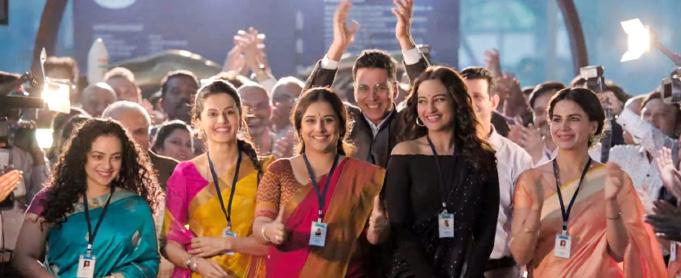
DIRECTOR: Jagan Shakti
HHH
Going to Mars is about as much of a challenge as chomping on a Mars bar - at least, that's the impression Mission Mangal gives. Akshay Kumar's latest ode to the nation so prioritises the need to match the feel-good spirit of an extended holiday weekend, that it misses out on setting up the drama and thrill of a scientific feat that is nothing short of historic for India. The film packs in essential masala. Director Jagan Shakti and his battery of co-screenwriters (R. Balki, Nidhi Singh Dharma and Saketh Kondiparthi) set up smaller subplots of melodrama to describe the personal lives of the protagonists - in rather unnecessary detail. For the lack of a genuine antagonist in the real-life saga it is
FACTS MESSED UP BY FICTION
BATLA HOUSE
STARRING: John Abraham, Mrunal Thakur, Ravi Kishen
DIRECTOR: Nikkhil Advani
HHH
In the media, the Batla House team has declared that their film is an attempt to seek definite answers to questions that still remain, regarding the alleged Batla House encounter in Delhi's Okhla area that happened in the aftermath of the 2008 serial blasts. Ironically, in a crucial courtroom scene of the climax, when the defence and prosecution are arguing to establish the guilt or innocence of a key suspect, an announcement appears on the screen stating that the filmmakers "do not endorse the viewpoint of either party".
You realise at that point where the problem with the film lies. Like most other mainstream Bollywood efforts claiming to bare truths, Batla House,
based on, the script invents a ‘villain’ too - by way of Dalip Tahil's NASAreturned Indian expert at ISRO, who sneers and snarls at every desi effort to do something original.
The story begins when an ambitious ISRO project goes kaput. Rakesh
Dhawan (Akshay Kumar), a maverick genius scientist who was in charge of the project, takes blame, although it was project director Tara Shinde (Vidya Balan) who was actually at fault.
Consequently, he is shunted to a project no one believes will ever take off: head India's mission to Mars. Despite the odds stacked up against the project, Tara manages to convince Rakesh the project could actually take off, with the right team and execution.
The script intertwines personal lives of Tara and her team with the account of the mission itself. So, Eka Gandhi, propulsion control expert (Sonakshi Sinha), hates most things Indian and wants to get away to NASA. Spacecraft
ORDINARY FILM ABOUT AN EXTRAORDINARY FEAT
anatomy designer Neha Siddiqui (Kirti Kulhari) is fighting social ostracism owing to her minority status. Navigation expert Krittika Agarwal (Taapsee Pannu) must, as a devoted wife, tend to her army-man husband when he is injured in the line of duty. Varsha Pillai (Nithya Menen), satellite designer, battles her mother-inlaw's taunts for being barren. Tara herself has her days full, balancing career, home, husband and two teenage kids.
These sub-stories distract from what the film was essentially supposed to be - a gripping drama of an overwhelming achievement. ISRO's Mars Orbiter Mission (MOM) was accomplished in record time, using minimal funds and skeletal infrastructure. It had to be realised in one attempt, as the reluctant space organisation was not too keen to shell out any more funds for the project. The gravity of such an achievement never really comes across.
almost apologetic to do so – the protagonist doles out a lecture on how the impressionable youth who get sucked into terrorism are not to be blamed, that the fault lies with the harbingers of religion who abuse faith to brainwash them.
It takes a while for the film to reach that sort of an indecisive stage, after the advantage of an impressive start is squandered away over the larger part of its nearly two-and-half hour runtime. Director Nikkhil Advani has credibly handled the genre of gritty thriller based on real-life terror in his 2013 release, D-Day. With Batla House he somehow struggles to maintain an urgency in the drama that unfolds.

To their credit, the writers have managed to keep the narrative lucid despite the fact that they were dealing with a heavily technical narrative.
Akshay Kumar, for a change, is only a catalyst here. Despite enjoying maximum footage, he actually lets the female protagonists push the plot. In fact, tellingly, when he is tipsy after a pub-hopping spree, a gang of girls protects him from ruffians.
Mission Mangal is a feel-good toast to girl power, and this is an advantage for its female cast. Vidya Balan, Sonakshi Sinha, Taapsee Pannu, Kirti Kulhari and Nithya Menen get wellcrafted roles that fit seamlessly to give the film its multi-starrer entirety.
Nonetheless, the film becomes mediocre somewhere down its runtime, an ordinary film about an extraordinary feat.
Vinayak Chakravorty
before Sanjay reached the spot.
John carries off the quasi-fictional creation Sanjay Kumar with admirable restraint, in what has to be a careerdefining role. As flawed screenwriting leads to uneven storytelling, the actor exudes tremendous screen presence to keep you engaged.
too, is hesitant when it comes to bluntly stating facts. When it does take a stand in the end, the film seems
John Abraham cuts a picture of gravitas as the film's hero Sanjay Kumar, the top cop in the line of fire after the encounter-op, because he headed it. The film would have us believe ACP Sanjay Kumar, who was in charge, did not give the go-ahead for the operation – that his immediate subordinate, Kishen Kumar Sharma (Ravi Kishen), took it upon himself to lead the cops into the building even
Batla House names Indian Mujahideen as the masterminds of the serial blasts but refuses to probe deeper. Sanjay's entire operation is overwhelmed by the demands of fiction, which affects its search for truth. While scenes of the hero's topsyturvy marriage hinders pace in the first half, Nora Fatehi's item number seems wholly out of place in what should have been an edge-of-the-seat second half.
John Abraham's act apart, there is not much to talk about among the cast.
Mrunal Thakur, seen recently in the Hrithik Roshan-starrer Super 30, suffers from a badly-penned role. Even a proven talent as Rajesh Sharma (as the defence lawyer) slips into the tendency to ham.
This could have been a terrific film. It remains a tepid effort.
Vinayak Chakravorty
AUGUST (2) 2019 33 NATIONAL EDITION
ENTERTAINMENT
Cruising to the South Pacific
BY PETRA O’NEILL

Once a year I join a cruise to relax and recharge, to a destination that offers balmy tropical days, crimson sunsets, swaying coconut palms and golden sandy beaches. Last year it was Vanuatu and New Caledonia aboard the Celebrity Solstice, and this year having packed my most dazzling sarongs, flip flops and a few good books, I cruised further eastwards to Fiji, Samoa and Tonga.
Joining the Celebrity Solstice in Auckland, I was welcomed with a glass of bubbly, escorted to my stateroom and immediately felt at home. For the relaxing days at sea, I enjoyed robust coffee and healthy breakfasts before visiting the well-equipped gym, walking a few laps around the exercise deck, and ending the morning with healthy salads for lunch. Afternoons were spent in the cosy library, and at the café where afternoon tea
was a treat, offerings included mini lemon tarts and eclairs.
For the evening cocktail, there are many bars to choose from and the dining options are all excellent, from Asian fusion to
Italian, French and Japanese.
The sleek lines and sophisticated design of the Celebrity Solstice’s exterior are matched by interior decor that is elegant and contemporary. Staterooms are
furnished with comfortable beds, a sitting area, vanity desk, ample wardrobe space, spacious bathrooms and a flat screen TV, and most have a balcony.
There are a wide variety of shops on-board, offering clothing, high end accessories, jewellery including a Tiffany’s store, duty free cosmetics and alcohol.
The pool deck is popular, with live music and activities happening while you work on a tan. The evening’s entertainment offers a wide range of performers to please everyone including comedians, magicians, singers, trapeze artists and musicians. On a large cruise ship such as the Celebrity Solstice, everything is provided for you.
At each port, we were given a warm welcome; big brass marching bands in Fiji, and rhythmic dancers accompanied by singing and bands of musicians in Tonga and Samoa, always with a warm send-off of more music, dance and lots of waving.


On arrival in Fiji, I joined a shore excursion to explore sights around Lautoka including Hindu temples, the bustling streets of Nadi, the garden of the sleeping giant established by the Hollywood actor

34 AUGUST (2) 2019 www.indianlink.com.au TRAVEL
It’s warm welcomes, beautiful beaches, heritage homes, bustling markets and lush landscapes - after some luxury sailing
Raymond Burr, and beautiful beaches. In Suva, an easy stroll led to the town centre, with the Museum, produce market and Indian spice shops all within walking distance.

We then cruised to Apia, Samoa, where I visited the former home of the author Robert Louis Stevenson who settled here in 1889, filled with antiques and memorabilia, the Immaculate Conception Cathedral, and vibrant market offering brightly coloured clothing, shell jewellery and souvenirs. A drive to the surrounding countryside was rewarded with lush tropical rainforests, waterfalls and stunning beaches, with a stop at Aggie Grey’s Hotel for a refreshing ale, the perfect way to end the day.
At Pago Pago, American Samoa, it was like stepping back in time, with only a handful of tourists visiting each year. Our guide said this past year had
been hectic with 9 cruise ships! In brightly painted open buses, decorated with red hibiscus flowers, we drove to a beautiful beach where we were entertained by guitar strumming musicians. The scenery is stunning with coconut palms, jagged rocky peaks, tropical rainforests and villages clinging to the shore-line around one of the world’s most dramatic natural harbours.
In Tonga, we arrived at the town of Neiafu, on the mountainous island of Vava’u. With friendly locals, churches, handicraft stores, a market, cafes and bakeries, this was a very pleasant destination.

At the capital, Nuku’alofa on the island of Tongatapu, Talamahu market offers a wide range of souvenirs. There are cafes, restaurants and ice cream parlours with long queues serving swirly bright green, pink and white ice-cream piled high onto cones. Our shore excursion took us to the Victorian style Royal Palace built in 1867, to Captain Cook’s landing site, ancient burial tombs, and drove past stunning stretches of coastline. Small farming plots appeared like a multi coloured patchwork growing different crops, lined with coconut, banana, breadfruit, and papaya trees. In each village, there are churches of several denominations and being Sunday, we listened to churchgoers, their melodious voices filling the air.
Wherever we went, we received a warm welcome, with lots of waving and calls of hello, perhaps appreciative that we’d come so far to visit their beautiful unspoilt island home.
TRAVEL NOTES
There is no easier way to get to a far-flung destination than on a cruise ship and there are many to choose from. Talk with a CLIA accredited travel agent who knows about cruising, though Celebrity Cruises and Royal Caribbean International will not disappoint. Celebrity Cruises will soon have two ships based in Australia, the Celebrity Solstice in Sydney and the Celebrity Eclipse in Melbourne. Celebrity Cruises is well suited to adults, though it does cater for children with its Camp at Sea program focussing on educational, culinary and art experiences. Royal Caribbean International is more energy charged offering many activities for children such as rock climbing walls, bumper cars and basketball. Check your sailing for what activities are available. Sign up for email alerts so you are the first to know about sales. And for first time cruisers, these ships are big and are fitted with stabilisers so you won’t feel a ripple.



AUGUST (2) 2019 35 NATIONAL EDITION
ASK AUNTYJI
Empire & (post) colonialism in English cricket
DEAR AUNTYJI
As you know, England recently won the Cricket World Cup on account of a metric that no one had even heard of. And now, in the Ashes, they are playing superbly all because they have decided that they are going to cherry pick the best players from all over the world and get them to play for good old England. Isn't it enough that these gore log tormented a large portion of the world during their so called Pax Britannica, and they continue to further the agenda of their dadagiri? I mean seriously, when are they going to learn that they can't just continue getting their way, especially in cricket. When is the tide going to turn, do you think?
AUNTYJI SAYS
Oh, I hear you, dost. Lekin kya kahen, humare colonial overlords thoda confused hain, nah? Well, they had the entire world in their hands until they were forced to cede control. Now they want Brexit. What to do? And as for cricket, I understand it was the choice of that shaitaan kiwi and that Barbados bowler who nearly killed our own Steve Smith. Lekin kya karen, in dono ki choice thi nah to play for Ol’ Blighty. We can't blame them for these life decisions. At least they didn't come to India and ask Rohit Sharma to join their team. Can you imagine what would have happened had Rohit became a deshdrohi? So let England vote for Brexit and then go begging around the world for good players. England ka muh to already kala hai na, from their zaleel harkatein. And I'm not just talking about the Koh-i-noor diamond saga here. Everyone knows that desperate times call for desperate measures. To jab sher zakhmi ho jaata hai, tub woh dhoondta hai ki koi uski madat kare. So rehne bhi do, nah. At least we are getting to see some very good cricket, kyon?
Facebook rules for married people
DEAR AUNTYJI
My 62-year-old friend Keith was recently in a car accident. He immediately posted a picture of this on Facebook. Now his wife Barbara was overseas at the time of the accident, and she found out through Facebook. She was very upset, and Keith can't understand what the big issue was. He said he did not want to wake her up because of the time difference, and he argued that it would have been obvious that he was ok as he was the one posting on Facebook. I am not sure I buy this line of reasoning, and I wanted your opinion on this. Do you think Keith made the wrong decision? My wife is on Keith's side by the way. I am more aligned to Barb's position - which is Keith should have called her before he posted on Facebook.
AUNTYJI SAYS
Ok, let me ask the real question here. What kind of person are you that you are friends with jahils who post things on Facebook. I mean really, I have put forward my position on Facebook long before the Russians were involved, and I did state that there is a special place in hell for people who live their lives on Facebook. So Keith is a bud tehzeeb buddhu, and his buddhupanti will rub off on you and make you a nasamajh as well. But to answer your question more directly, Keith was dumb to post on social media before he spoke to his wife. It would appear that when he joined Facebook, apne dimaag ko taala lagakar, usne chaabi phenk di. Not only is he stupid, he is a bekaar husband as well. To hamari samajh mein, you should avoid Keith in the future, because it is likely you will turn out to be a bevakoof like him also.
DO YOU HAVE A QUESTION FOR AUNTYJI? EMAIL INFO@INDIANLINK.COM.AU

MATRIMONIALS
Young, Singapore. Caste no bar. Only child in family, both parents are doctors. Please contact lalitm67@gmail.com, phone 0411 058 064
Seeking professionally qualified well settled match from Sydney for ’88born, 5"3" Hindu Punjabi girl, divorced (concluded) with brief marriage of 1.5 years. Working full time with a leading University in Sydney. Pref teetotaller. Aus PR or citizen only.

Email:matrimonial.ml@gmail.com






SEEKING BRIDES
SEEKING GROOMS
Beautiful, highly educated (very good family background), soft spoken, careeroriented 33-year-old vegetarian Brahmin girl, working, well settled in Sydney, seeks an educated matchm teetotaller with good family background. Prefer Australian citizen or PR. Please contact rajsyd83@gmail.com
Seeking well-settled boy in Australia (businessman or professional) for a Hindu Khatri (never married) India-based girl, 5'3", beautiful, slim, very fair, vegetarian, post-graduate, December 1985 born. Currently in Australia (visitor’s visa). Brother settled in Melbourne. Contact +61 456 604 747, or email 9gannu@gmail.com
Seeking groom for my niece, beautiful, 30, 5’ 5”, fair, pleasing personality, Management Consultant in Ernst and
Seeking match for educated, well settled Gujarati boy with own home in Sydney, earning 180+k per annum, divorced, 5’9", 1980 born, Australian citizen. Looking for Citizen/PR match ONLY preferably from Sydney.
Phone 0490 970 281 (leave message if busy) or email patelbrij1980@gmail.com
Professional match for Punjabi boy, 34, 5'11", fair, B.Com/BBA, Chartered Accountant, Australian citizen, working as Manager with a major bank in Sydney. Girl should be Hindu, 26 to 32, professionally qualified, Australian citizen or PR, and must be Sydney based. Please send photo & details tosanjdeep6@gmail.com.
Match intercaste, for Hindu Kayasth 32, 5'8”, teetotaller, MBA, Axis Bank Manager, Jaipur, India. May shift to Australia. Never married. Looking for Indian/Australian citizen girl. Should be professionally qualified, vegetarian.

Email: gsbhatnagar16@gmail.com or risi1986@yahoo.com.

Phone: +919828536328 or +919660934538

36 AUGUST (2) 2019 www.indianlink.com.au BACKCHAT
AUGUST (2) 2019 37 NATIONAL EDITION





38 AUGUST (2) 2019 www.indianlink.com.au





AUGUST (2) 2019 39 NATIONAL EDITION





40 AUGUST (2) 2019 www.indianlink.com.au












































































































 BY NANDITHA SURESH
BY NANDITHA SURESH


















 BY CHITRA SUDARSHAN
BY CHITRA SUDARSHAN






















 Subhash K Jha
Subhash K Jha































